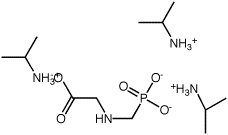Glyphosate isopropylamine salt
- Bronco
- Glifonox
- Glyphosate mono(Isopropylamine) salt
- Isopropylamine salt of n-(phosphono-methyl)glycine
- n-(Phosphonomethyl)glycine isopropylamine salt
- n-(Phosphonomethyl)glycine isopropylammonium salt

Glyphosate isopropylamine salt | |
| |
| Formula | C3H9N.C3H8NO5P |
| Structure |  |
| Description | Clear, viscous amber-colored solution. Practically odorless to slight amine-like odor. |
| Uses | Herbicide. |
Registry Numbers. | |
| CAS | 38641-94-0 |
| EINECS | 254-056-8 |
| RTECS | MC1080000 |
| EPA Pest. No. | 103601 |
| 38641-94-0 is not listed on the TSCA. | |
Chemical and physical properties. | |
| Formula mass | 228.22 |
Hazards and protection. | |
| Storage | Store above 10oF to prevent crystallizing. If allowed to crystallize, place in warm room 68oF for several days to redissolve; mix well before reuse. |
| Handling | All chemicals should be considered hazardous. Avoid direct physical contact. Use appropriate, approved safety equipment. Untrained individuals should not handle this chemical or its container. Handling should occur in a chemical fume hood. |
| Protection | Long-sleeved shirt, long pants, chemical protective gloves. Goggles during mixing/pouring operations in which eye contact is likely to occur. |
| Respirators | Use NIOSH/MSHA approved respirator appropriate for exposure of concern. |
| Small spills or leaks | Evacuate area and ventilate. Wear protective equipment. If required, use an inert absrobent. Sweep up and place in an appropriate container for disposal. Wash contaminated surfaces. |
| Stability | Stable up to 5 years under normal conditions. |
Fire related information. | ||||
| Fire fighting | Water spray, foam, dry chemical, carbon dioxide or any class b agent. | |||
Health related information. | |
Exposure effects | |
| Mental status changes may be seen late in the course of glyphosate poisoning. | |
| Ingestion | Common signs - nausea and vomiting; erythema of mucous membranes; epigastric pain. |
| Inhalation | Life-threatening effects include pulmonary edema and aspiration pneumonitis. Irritation occurs. |
| Skin | Commercial glyphosate formulations have caused erythema, piloerection, and contact dermatitis. |
| First aid | |
| Ingestion | Rinse the mouth and dilute with milk or water. For smaller ingestions, oral irrigation and dilution may be all that is necessary. Emesis is not recommended, although spontaneous vomiting may occur. Administer activated charcoal and cathartic. |
| Inhalation | If symptoms develop, move individual away from exposure and into fresh air. If symptoms persist, seek medical attention. If breathing is difficult, administer oxygen. Keep person warm and quiet; seek immediate medical attention. |
| Skin | Remove clothing and wash skin, including hair. |
| Eyes | Irrigate exposed eyes with copious amounts of tepid water for at least 15 minutes. If irritation, pain, swelling, lacrimation, or photophobia persist, the patient should be seen in a health care facility. |